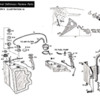Remember if you expect to run a quiet in-tank pump, pick one that fits thru the existing hole for the sender, or maybe the tank vent (smaller). As for the riveted tank vent, I drilled out the rivets, found the tank holes already euro-threaded, so it was simple to replace the stock vent with Hall's economical anti-roll-over valve assembly (now mandatory for passenger cars & light trucks world wide).
DeTomaso supplied roll-over valves on the '80-up wide-body cars and probably on Longchamps etc made after '80. But factory parts today are unbelievably expensive and mostly unobtainium. I've never, in many million miles, rolled a car or truck. But if the worst happens, I don't want to be bathing in 91-octane along with a smoking-hot engine, for want of a $50 part.


